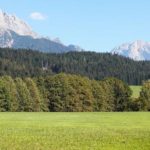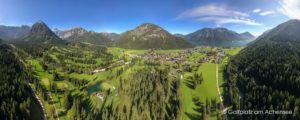
„Wenn einer einen blütenreichen Frühling und einen satten Herbst erlebt, so muss er sich doch eingestehen, dass es schön ist, Mensch zu sein.“ (Kumagai Naoyoshi, 1782-1862)
Wir Golfer lieben den Herbst! Und wie! Die letzten wohlig warmen Sonnentage des Spätsommers und eine farbenfrohe Natur. Wenn da bloß nicht dieser graue, triste Nebel wäre. Der ist weitaus weniger schön und bringt auf dem Golfplatz mitunter große Gefahren mit sich. Wenn beispielsweise die Sicht so schlecht ist, dass man die Flugbahn des Balles nur noch erahnen kann, oder nicht mehr mitbekommt, ob und wo sich andere Flights auf den Spielbahnen bewegen. Es gibt genügend Erzählungen von Menschen, für die es da draußen im Nebeldickicht schon einmal richtig gefährlich geworden ist.
Losgespielt, vor einem weit und breit niemand. Dahinter auch nicht. Plötzlich schlägt die Kugel direkt daneben ein. Und der völlig verdutzte Spieler frägt vorwurfsvoll, warum man denn einfach auf Bahn 3 und nicht auf der Eins angefangen habe zu spielen. War aber freilich gar nicht so. Begonnen wurde, ganz ordnungsgemäß, wie von allen anderen von vorne. Nur quasi mit der Tarnkappe des Nebels. Obwohl die Sicherheit auf dem Platz dadurch möglicherweise nicht mehr gewährleistet ist, gibt es in den offiziellen Golfregeln keine speziellen Absätze, die sich mit dieser Thematik befassen.
Experten sagen: Man kann Nebel analog zu Gewitter sehen. Denn auch bei Nebel kann es sehr gefährlich werden. Es gibt schließlich Regionen, in denen sich schon wegen der speziellen geografischen Lage oft dichter Nebel bildet. In Flusstälern zum Beispiel oder an Seen. Im Salzkammergut oder in den Gebirgsregionen des Tiroler Unterlands. Mancher Golfclub hat auf diese äußeren Bedingungen bereits reagiert und auf dem Weg zum ersten Abschlag ein Hinweisschild angebracht: Spielen, heißt es oft, sei erst ab einer Sichtweite von mindestens 250 Metern erlaubt. Jeder Spieler ist logischerweise trotzdem für sich selbst verantwortlich. Nur bei Turnieren obliegt es der Spielleitung, diese Entscheidung zu treffen. Auf anderen Plätzen wiederum gilt das Prinzip der gegenseitigen Rücksichtnahme. Denn trüb kann die Sicht ganz plötzlich werden. Je nach Sichtweite weiß niemand, ob er mit seinem Schlag zum Beispiel andere Golfer oder Greenkeeper gefährdet. Ein Warnruf ist somit auch nicht möglich. Der mögliche Ballverlust ist nur das kleinste Risiko.
Auch auf den Profi-Touren gibt es immer wieder Probleme mit dem Nebel. Golfturniere bei Amateuren und Profis werden unterbrochen, wenn der Ballflug und die Landung des Balles wegen dichten Nebels nicht zu sehen sind. Die Entscheidung, wann das Turnier unterbrochen wird, trifft die Turnierleitung vor Ort. Bei Turnieren über mehrere Tage und mit mehreren Runden wird meist am folgenden Tag zu Ende gespielt. Eine andere Wahl, beispielsweise eine Verkürzung auf neun Löcher, gibt es nicht. Ob es letztlich tatsächlich Spaß macht, bei Nebel zu spielen? Wohl weniger. Die Handbremse im Kopf ist stets angezogen, man kann nie voll durchziehen. Das wäre dann in etwa so, wie bei schlechter Sicht mit 200 Stundenkilometer über die Autobahn zu rasen. Ziemlich verrückt und rücksichtslos.
In den Golf-Alpin-Regionen Tirols und im Salzburger Land kann man auch im Herbst freilich noch länger ohne das Übel Nebel auf den Golfplatz gehen. Der Kraft der lieben Sonne sei Dank! Auf dem Mieminger Plateau beispielsweise, dem erklärten Nacherholungsgebiet der Innsbrucker. Das Plateau gehört zu den anmutigsten Landschaften Tirols – mit Weite, idealer Höhenlage, intensiver Sonneneinstrahlung und einem wunderbaren Golfplatz, der Golf-Alpin-Partneranlage ist. Diese exponierte Lage bestätigen auch die jährlichen Statistiken der Meteorologen: Die Region Innsbruck zum Beispiel zählte im Jahr 2017 mit 2043 Sonnenstunden zu den stahlendsten Ecken Österreichs. Richtig dicken Nebel gibt’s wo anders: Die wahrscheinlich nebeligste Ecke der Welt sind die Grand Banks in Neufundland an der Ostküste Kanadas, wo an mehr als 120 Tagen pro Jahr Sichtweiten von weniger als einem Kilometer herrschen. Und der schottische Berg Ben Nevis soll laut Guinness-Buch der Rekorde sogar an 300 Tagen im Jahr in Nebel gehüllt sein.
Fotos: (Titelfoto) Stefan von Stengel, (1) Fotalia, (3 – 6) Golfpark Mieminger Plateau








